ESP VOLVO XC60 TWIN ENGINE 2019 Repair Manual
[x] Cancel search | Manufacturer: VOLVO, Model Year: 2019, Model line: XC60 TWIN ENGINE, Model: VOLVO XC60 TWIN ENGINE 2019Pages: 695, PDF Size: 14.96 MB
Page 369 of 695
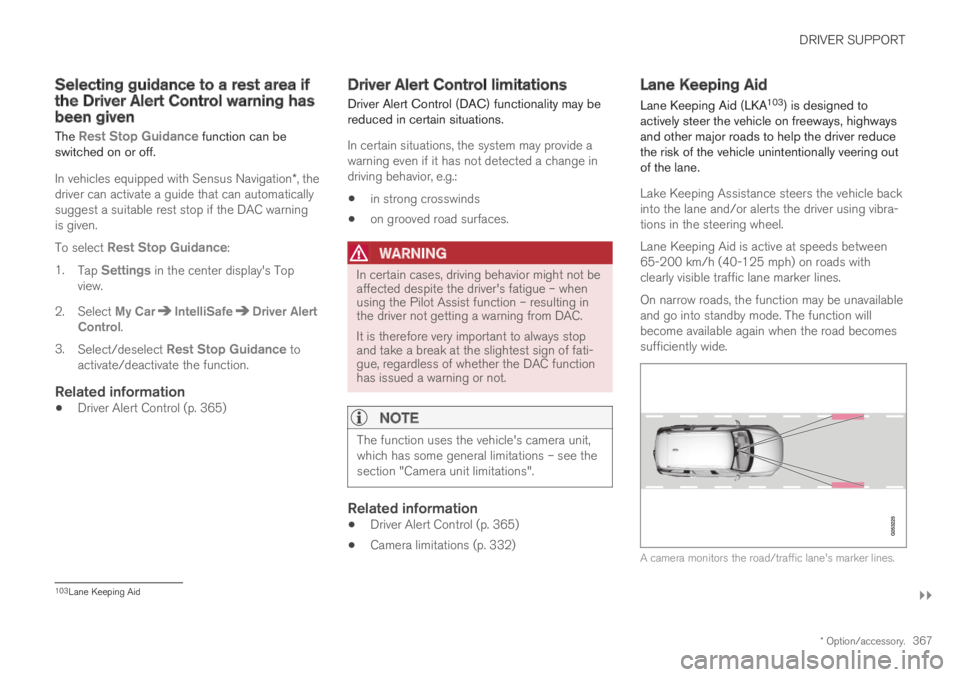
DRIVER SUPPORT
}}
* Option/accessory.367
Selecting guidance to a rest area ifthe Driver Alert Control warning hasbeen given
The Rest Stop Guidance function can beswitched on or off.
In vehicles equipped with Sensus Navigation*, thedriver can activate a guide that can automaticallysuggest a suitable rest stop if the DAC warningis given.
To select Rest Stop Guidance:
1.Tap Settings in the center display's Topview.
2.Select My CarIntelliSafeDriver AlertControl.
3.Select/deselect Rest Stop Guidance toactivate/deactivate the function.
Related information
Driver Alert Control (p. 365)
Driver Alert Control limitations
Driver Alert Control (DAC) functionality may bereduced in certain situations.
In certain situations, the system may provide awarning even if it has not detected a change indriving behavior, e.g.:
in strong crosswinds
on grooved road surfaces.
WARNING
In certain cases, driving behavior might not beaffected despite the driver's fatigue – whenusing the Pilot Assist function – resulting inthe driver not getting a warning from DAC.
It is therefore very important to always stopand take a break at the slightest sign of fati-gue, regardless of whether the DAC functionhas issued a warning or not.
NOTE
The function uses the vehicle's camera unit,which has some general limitations – see thesection "Camera unit limitations".
Related information
Driver Alert Control (p. 365)
Camera limitations (p. 332)
Lane Keeping Aid
Lane Keeping Aid (LKA103) is designed toactively steer the vehicle on freeways, highwaysand other major roads to help the driver reducethe risk of the vehicle unintentionally veering outof the lane.
Lake Keeping Assistance steers the vehicle backinto the lane and/or alerts the driver using vibra-tions in the steering wheel.
Lane Keeping Aid is active at speeds between65-200 km/h (40-125 mph) on roads withclearly visible traffic lane marker lines.
On narrow roads, the function may be unavailableand go into standby mode. The function willbecome available again when the road becomessufficiently wide.
A camera monitors the road/traffic lane's marker lines.
103Lane Keeping Aid
Page 370 of 695
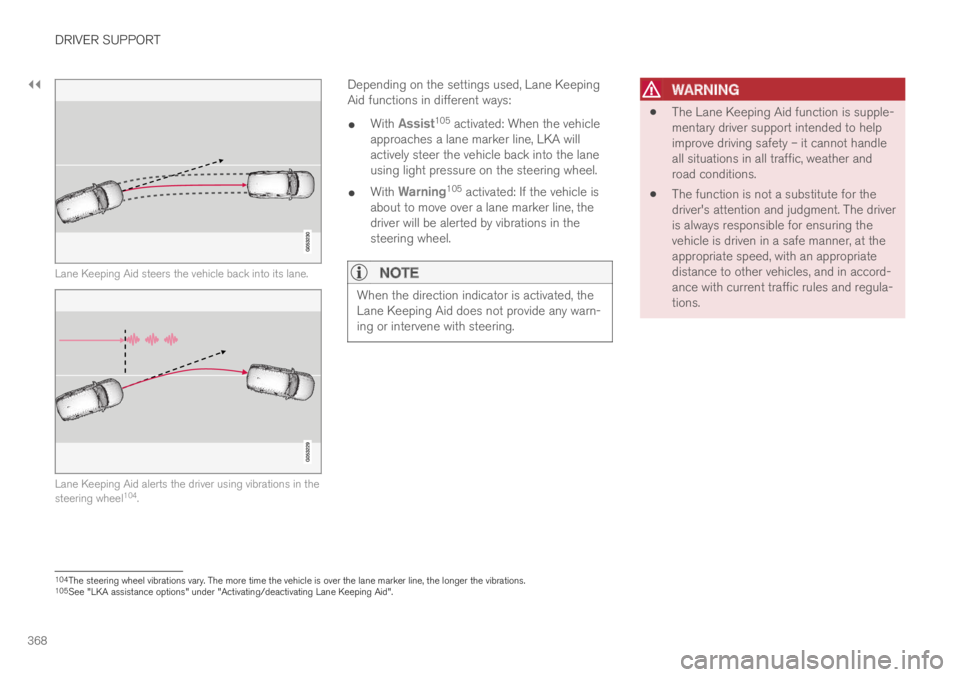
||
DRIVER SUPPORT
368
Lane Keeping Aid steers the vehicle back into its lane.
Lane Keeping Aid alerts the driver using vibrations in thesteering wheel104.
Depending on the settings used, Lane KeepingAid functions in different ways:
With Assist105 activated: When the vehicleapproaches a lane marker line, LKA willactively steer the vehicle back into the laneusing light pressure on the steering wheel.
With Warning105 activated: If the vehicle isabout to move over a lane marker line, thedriver will be alerted by vibrations in thesteering wheel.
NOTE
When the direction indicator is activated, theLane Keeping Aid does not provide any warn-ing or intervene with steering.
WARNING
The Lane Keeping Aid function is supple-mentary driver support intended to helpimprove driving safety – it cannot handleall situations in all traffic, weather androad conditions.
The function is not a substitute for thedriver's attention and judgment. The driveris always responsible for ensuring thevehicle is driven in a safe manner, at theappropriate speed, with an appropriatedistance to other vehicles, and in accord-ance with current traffic rules and regula-tions.
104The steering wheel vibrations vary. The more time the vehicle is over the lane marker line, the longer the vibrations.105See "LKA assistance options" under "Activating/deactivating Lane Keeping Aid".
Page 378 of 695
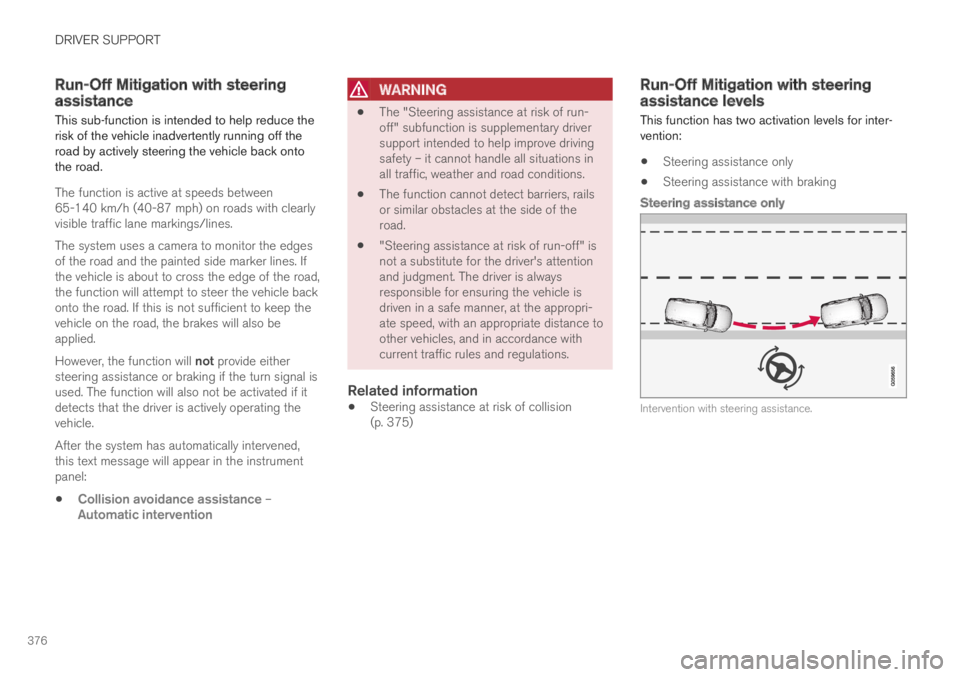
DRIVER SUPPORT
376
Run-Off Mitigation with steeringassistance
This sub-function is intended to help reduce therisk of the vehicle inadvertently running off theroad by actively steering the vehicle back ontothe road.
The function is active at speeds between65-140 km/h (40-87 mph) on roads with clearlyvisible traffic lane markings/lines.
The system uses a camera to monitor the edgesof the road and the painted side marker lines. Ifthe vehicle is about to cross the edge of the road,the function will attempt to steer the vehicle backonto the road. If this is not sufficient to keep thevehicle on the road, the brakes will also beapplied.
However, the function will not provide eithersteering assistance or braking if the turn signal isused. The function will also not be activated if itdetects that the driver is actively operating thevehicle.
After the system has automatically intervened,this text message will appear in the instrumentpanel:
Collision avoidance assistance –Automatic intervention
WARNING
The "Steering assistance at risk of run-off" subfunction is supplementary driversupport intended to help improve drivingsafety – it cannot handle all situations inall traffic, weather and road conditions.
The function cannot detect barriers, railsor similar obstacles at the side of theroad.
"Steering assistance at risk of run-off" isnot a substitute for the driver's attentionand judgment. The driver is alwaysresponsible for ensuring the vehicle isdriven in a safe manner, at the appropri-ate speed, with an appropriate distance toother vehicles, and in accordance withcurrent traffic rules and regulations.
Related information
Steering assistance at risk of collision(p. 375)
Run-Off Mitigation with steeringassistance levels
This function has two activation levels for inter-vention:
Steering assistance only
Steering assistance with braking
Steering assistance only
Intervention with steering assistance.
Page 381 of 695
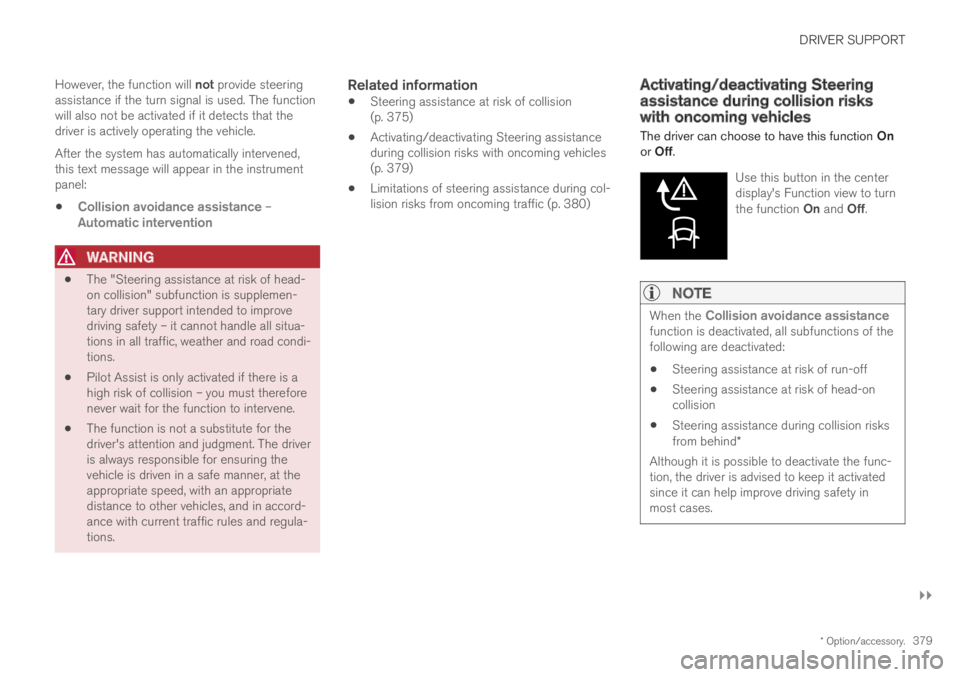
DRIVER SUPPORT
}}
* Option/accessory.379
However, the function will not provide steeringassistance if the turn signal is used. The functionwill also not be activated if it detects that thedriver is actively operating the vehicle.
After the system has automatically intervened,this text message will appear in the instrumentpanel:
Collision avoidance assistance –Automatic intervention
WARNING
The "Steering assistance at risk of head-on collision" subfunction is supplemen-tary driver support intended to improvedriving safety – it cannot handle all situa-tions in all traffic, weather and road condi-tions.
Pilot Assist is only activated if there is ahigh risk of collision – you must thereforenever wait for the function to intervene.
The function is not a substitute for thedriver's attention and judgment. The driveris always responsible for ensuring thevehicle is driven in a safe manner, at theappropriate speed, with an appropriatedistance to other vehicles, and in accord-ance with current traffic rules and regula-tions.
Related information
Steering assistance at risk of collision(p. 375)
Activating/deactivating Steering assistanceduring collision risks with oncoming vehicles(p. 379)
Limitations of steering assistance during col-lision risks from oncoming traffic (p. 380)
Activating/deactivating Steeringassistance during collision riskswith oncoming vehicles
The driver can choose to have this function Onor Off.
Use this button in the centerdisplay's Function view to turnthe function On and Off.
NOTE
When the Collision avoidance assistancefunction is deactivated, all subfunctions of thefollowing are deactivated:
Steering assistance at risk of run-off
Steering assistance at risk of head-oncollision
Steering assistance during collision risksfrom behind*
Although it is possible to deactivate the func-tion, the driver is advised to keep it activatedsince it can help improve driving safety inmost cases.
Page 383 of 695
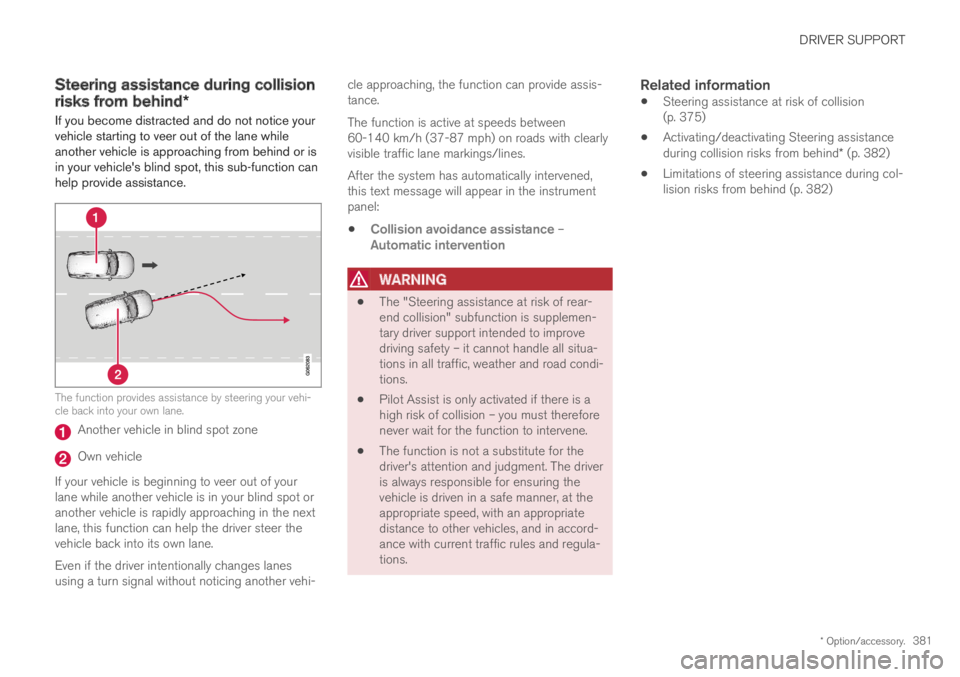
DRIVER SUPPORT
* Option/accessory.381
Steering assistance during collision
risks from behind*
If you become distracted and do not notice yourvehicle starting to veer out of the lane whileanother vehicle is approaching from behind or isin your vehicle's blind spot, this sub-function canhelp provide assistance.
The function provides assistance by steering your vehi-cle back into your own lane.
Another vehicle in blind spot zone
Own vehicle
If your vehicle is beginning to veer out of yourlane while another vehicle is in your blind spot oranother vehicle is rapidly approaching in the nextlane, this function can help the driver steer thevehicle back into its own lane.
Even if the driver intentionally changes lanesusing a turn signal without noticing another vehi-
cle approaching, the function can provide assis-tance.
The function is active at speeds between60-140 km/h (37-87 mph) on roads with clearlyvisible traffic lane markings/lines.
After the system has automatically intervened,this text message will appear in the instrumentpanel:
Collision avoidance assistance –Automatic intervention
WARNING
The "Steering assistance at risk of rear-end collision" subfunction is supplemen-tary driver support intended to improvedriving safety – it cannot handle all situa-tions in all traffic, weather and road condi-tions.
Pilot Assist is only activated if there is ahigh risk of collision – you must thereforenever wait for the function to intervene.
The function is not a substitute for thedriver's attention and judgment. The driveris always responsible for ensuring thevehicle is driven in a safe manner, at theappropriate speed, with an appropriatedistance to other vehicles, and in accord-ance with current traffic rules and regula-tions.
Related information
Steering assistance at risk of collision(p. 375)
Activating/deactivating Steering assistanceduring collision risks from behind* (p. 382)
Limitations of steering assistance during col-lision risks from behind (p. 382)
Page 387 of 695
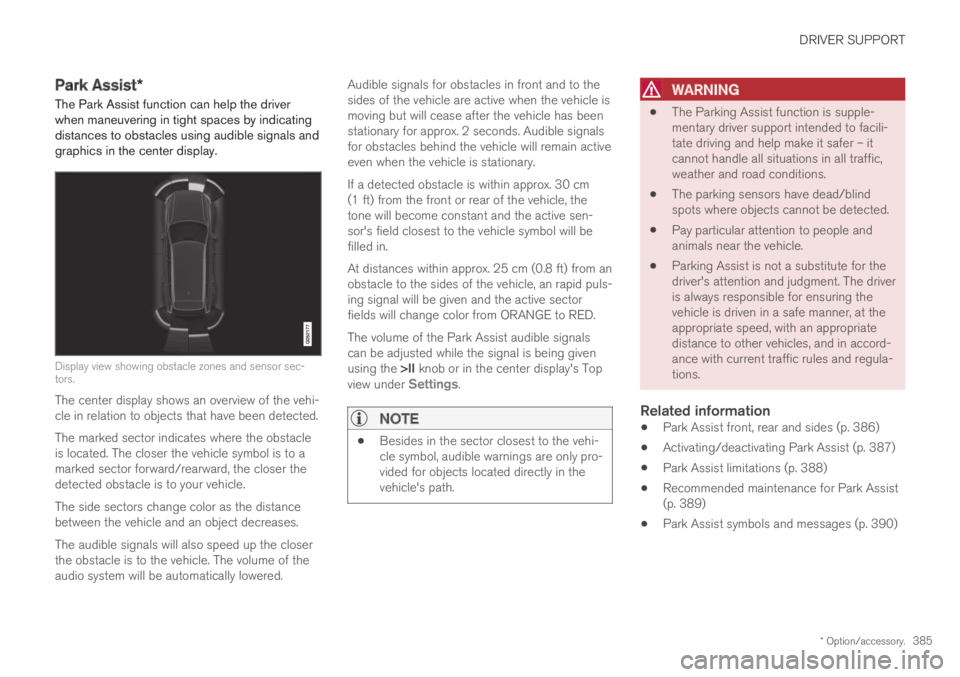
DRIVER SUPPORT
* Option/accessory.385
Park Assist*
The Park Assist function can help the driverwhen maneuvering in tight spaces by indicatingdistances to obstacles using audible signals andgraphics in the center display.
Display view showing obstacle zones and sensor sec-tors.
The center display shows an overview of the vehi-cle in relation to objects that have been detected.
The marked sector indicates where the obstacleis located. The closer the vehicle symbol is to amarked sector forward/rearward, the closer thedetected obstacle is to your vehicle.
The side sectors change color as the distancebetween the vehicle and an object decreases.
The audible signals will also speed up the closerthe obstacle is to the vehicle. The volume of theaudio system will be automatically lowered.
Audible signals for obstacles in front and to thesides of the vehicle are active when the vehicle ismoving but will cease after the vehicle has beenstationary for approx. 2 seconds. Audible signalsfor obstacles behind the vehicle will remain activeeven when the vehicle is stationary.
If a detected obstacle is within approx. 30 cm(1 ft) from the front or rear of the vehicle, thetone will become constant and the active sen-sor's field closest to the vehicle symbol will befilled in.
At distances within approx. 25 cm (0.8 ft) from anobstacle to the sides of the vehicle, an rapid puls-ing signal will be given and the active sectorfields will change color from ORANGE to RED.
The volume of the Park Assist audible signalscan be adjusted while the signal is being givenusing the >II knob or in the center display's Topview under Settings.
NOTE
Besides in the sector closest to the vehi-cle symbol, audible warnings are only pro-vided for objects located directly in thevehicle's path.
WARNING
The Parking Assist function is supple-mentary driver support intended to facili-tate driving and help make it safer – itcannot handle all situations in all traffic,weather and road conditions.
The parking sensors have dead/blindspots where objects cannot be detected.
Pay particular attention to people andanimals near the vehicle.
Parking Assist is not a substitute for thedriver's attention and judgment. The driveris always responsible for ensuring thevehicle is driven in a safe manner, at theappropriate speed, with an appropriatedistance to other vehicles, and in accord-ance with current traffic rules and regula-tions.
Related information
Park Assist front, rear and sides (p. 386)
Activating/deactivating Park Assist (p. 387)
Park Assist limitations (p. 388)
Recommended maintenance for Park Assist(p. 389)
Park Assist symbols and messages (p. 390)
Page 393 of 695
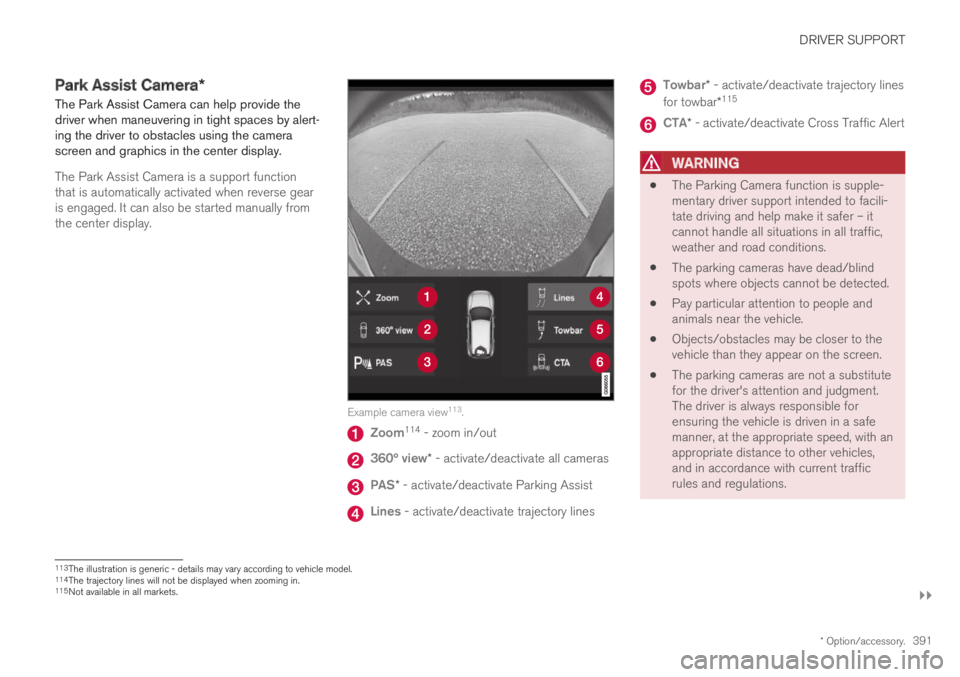
DRIVER SUPPORT
}}
* Option/accessory.391
Park Assist Camera*
The Park Assist Camera can help provide thedriver when maneuvering in tight spaces by alert-ing the driver to obstacles using the camerascreen and graphics in the center display.
The Park Assist Camera is a support functionthat is automatically activated when reverse gearis engaged. It can also be started manually fromthe center display.
Example camera view113.
Zoom114 - zoom in/out
360° view* - activate/deactivate all cameras
PAS* - activate/deactivate Parking Assist
Lines - activate/deactivate trajectory lines
Towbar* - activate/deactivate trajectory lines
for towbar*115
CTA* - activate/deactivate Cross Traffic Alert
WARNING
The Parking Camera function is supple-mentary driver support intended to facili-tate driving and help make it safer – itcannot handle all situations in all traffic,weather and road conditions.
The parking cameras have dead/blindspots where objects cannot be detected.
Pay particular attention to people andanimals near the vehicle.
Objects/obstacles may be closer to thevehicle than they appear on the screen.
The parking cameras are not a substitutefor the driver's attention and judgment.The driver is always responsible forensuring the vehicle is driven in a safemanner, at the appropriate speed, with anappropriate distance to other vehicles,and in accordance with current trafficrules and regulations.
113The illustration is generic - details may vary according to vehicle model.114The trajectory lines will not be displayed when zooming in.115Not available in all markets.
Page 403 of 695
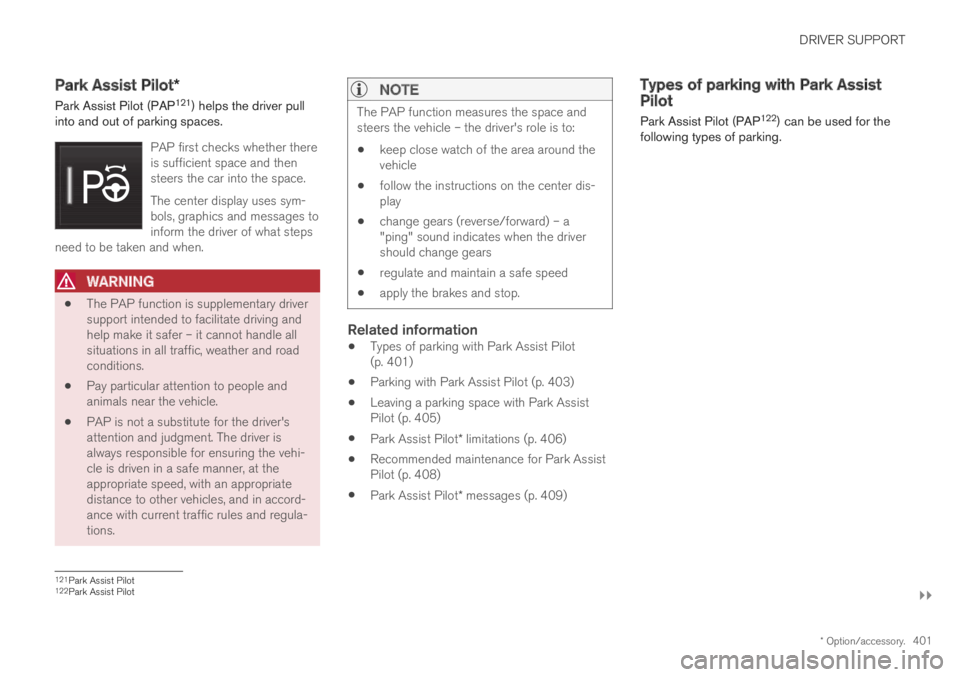
DRIVER SUPPORT
}}
* Option/accessory.401
Park Assist Pilot*
Park Assist Pilot (PAP121) helps the driver pullinto and out of parking spaces.
PAP first checks whether thereis sufficient space and thensteers the car into the space.
The center display uses sym-bols, graphics and messages toinform the driver of what stepsneed to be taken and when.
WARNING
The PAP function is supplementary driversupport intended to facilitate driving andhelp make it safer – it cannot handle allsituations in all traffic, weather and roadconditions.
Pay particular attention to people andanimals near the vehicle.
PAP is not a substitute for the driver'sattention and judgment. The driver isalways responsible for ensuring the vehi-cle is driven in a safe manner, at theappropriate speed, with an appropriatedistance to other vehicles, and in accord-ance with current traffic rules and regula-tions.
NOTE
The PAP function measures the space andsteers the vehicle – the driver's role is to:
keep close watch of the area around thevehicle
follow the instructions on the center dis-play
change gears (reverse/forward) – a"ping" sound indicates when the drivershould change gears
regulate and maintain a safe speed
apply the brakes and stop.
Related information
Types of parking with Park Assist Pilot(p. 401)
Parking with Park Assist Pilot (p. 403)
Leaving a parking space with Park AssistPilot (p. 405)
Park Assist Pilot* limitations (p. 406)
Recommended maintenance for Park AssistPilot (p. 408)
Park Assist Pilot* messages (p. 409)
Types of parking with Park AssistPilot
Park Assist Pilot (PAP122) can be used for thefollowing types of parking.
121Park Assist Pilot122Park Assist Pilot
Page 404 of 695
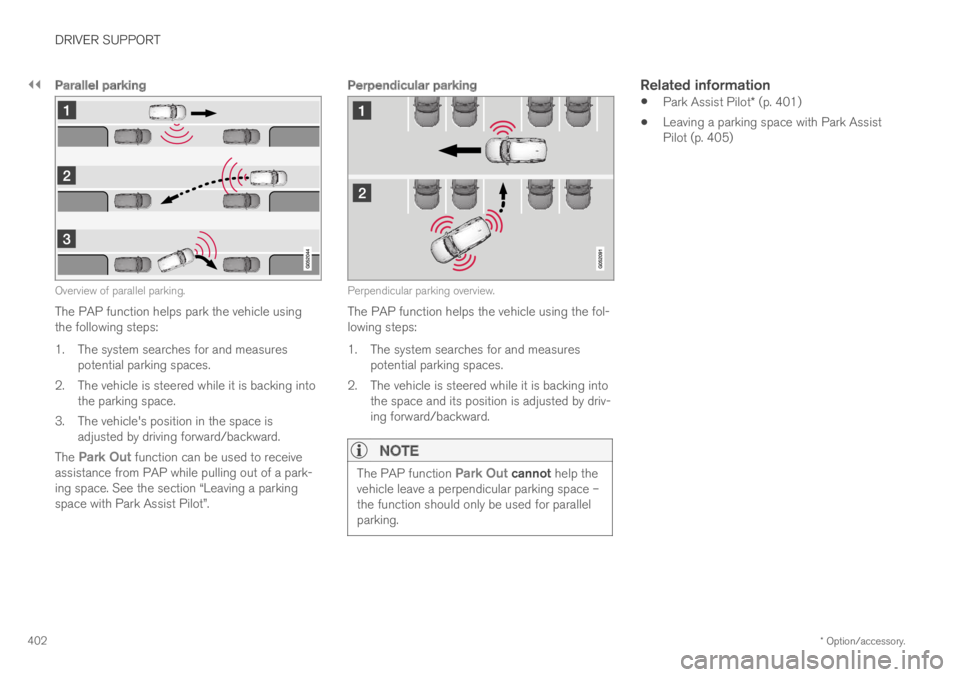
||
DRIVER SUPPORT
* Option/accessory.402
Parallel parking
Overview of parallel parking.
The PAP function helps park the vehicle usingthe following steps:
1.The system searches for and measurespotential parking spaces.
2. The vehicle is steered while it is backing intothe parking space.
3. The vehicle's position in the space isadjusted by driving forward/backward.
The Park Out function can be used to receiveassistance from PAP while pulling out of a park-ing space. See the section “Leaving a parkingspace with Park Assist Pilot”.
Perpendicular parking
Perpendicular parking overview.
The PAP function helps the vehicle using the fol-lowing steps:
1.The system searches for and measurespotential parking spaces.
2. The vehicle is steered while it is backing intothe space and its position is adjusted by driv-ing forward/backward.
NOTE
The PAP function Park Out cannot help thevehicle leave a perpendicular parking space –the function should only be used for parallelparking.
Related information
Park Assist Pilot* (p. 401)
Leaving a parking space with Park AssistPilot (p. 405)
Page 405 of 695
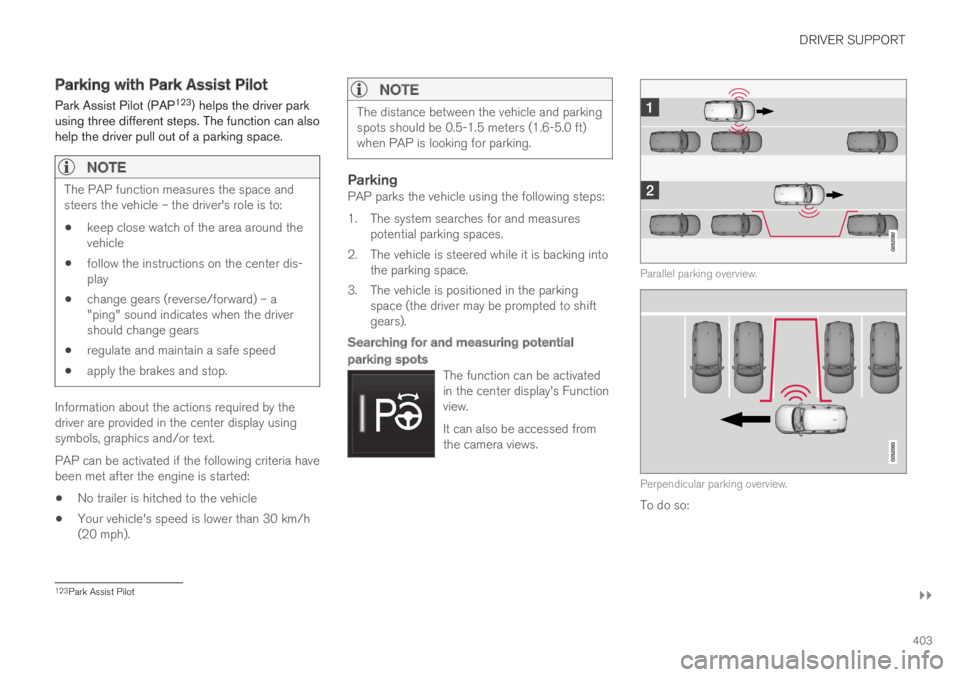
DRIVER SUPPORT
}}
403
Parking with Park Assist Pilot
Park Assist Pilot (PAP123) helps the driver parkusing three different steps. The function can alsohelp the driver pull out of a parking space.
NOTE
The PAP function measures the space andsteers the vehicle – the driver's role is to:
keep close watch of the area around thevehicle
follow the instructions on the center dis-play
change gears (reverse/forward) – a"ping" sound indicates when the drivershould change gears
regulate and maintain a safe speed
apply the brakes and stop.
Information about the actions required by thedriver are provided in the center display usingsymbols, graphics and/or text.
PAP can be activated if the following criteria havebeen met after the engine is started:
No trailer is hitched to the vehicle
Your vehicle's speed is lower than 30 km/h(20 mph).
NOTE
The distance between the vehicle and parkingspots should be 0.5-1.5 meters (1.6-5.0 ft)when PAP is looking for parking.
Parking
PAP parks the vehicle using the following steps:
1. The system searches for and measurespotential parking spaces.
2. The vehicle is steered while it is backing intothe parking space.
3. The vehicle is positioned in the parkingspace (the driver may be prompted to shiftgears).
Searching for and measuring potential
parking spots
The function can be activatedin the center display's Functionview.
It can also be accessed fromthe camera views.
Parallel parking overview.
Perpendicular parking overview.
To do so:
123Park Assist Pilot